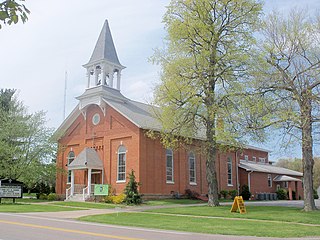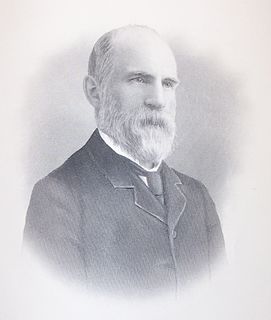Related Research Articles

Lowellville is a village in Mahoning County, Ohio, United States, in the "Steel Valley" area of the northeast part of the state, southeast of Youngstown. The village is an older, predominantly Italian-American, working-class community built along the banks of the Mahoning River, and centered on the once productive Sharon Steel works. The population was 1,155 at the 2010 census. It is part of the Youngstown-Warren-Boardman, OH-PA Metropolitan Statistical Area.

Struthers is a city in Mahoning County, Ohio, United States. The population was 10,713 at the 2010 census. It is part of the Youngstown-Warren-Boardman, OH-PA Metropolitan Statistical Area.

Youngstown is a city in the U.S. state of Ohio, and the largest city and county seat of Mahoning County. According to the 2020 United States Census, Youngstown had a city population of 60,068. The Youngstown-Warren-Boardman, OH-PA Metropolitan Statistical Area, with a population of 541,243 is the 107th-largest metropolitan area in the United States.

Little Italy is a general name for an ethnic enclave populated primarily by Italians or people of Italian ancestry, usually in an urban neighborhood. The concept of "Little Italy" holds many different aspects of the Italian culture. There are shops selling Italian goods as well as Italian restaurants lining the streets. A "Little Italy" strives essentially to have a version of the country of Italy placed in the middle of a large non-Italian city. This sort of enclave is often the result of periods of immigration in the past, during which people of the same culture settled together in certain areas. As cities modernized and grew, these areas became known for their ethnic associations, and ethnic neighborhoods like "Little Italy" blossomed, becoming the icons they are today.

The Mahoning River is a river located in northeastern Ohio and a small portion of western Pennsylvania. Flowing primarily through several Ohio counties, it crosses the state line into Pennsylvania before joining with the Shenango River to form the Beaver River. The Mahoning River drops from 1,296 feet (395 m) at the headwaters near Winona to 761 feet (232 m) at the outfall near Mahoningtown, Pennsylvania. It is part of the Ohio River watershed.
Lansingville is a neighborhood in Youngstown, Ohio. Located on the city's south side, the area was named for John Lansing. The neighborhood was dominated by Slovak Americans, the majority of whom were Roman Catholic, during much of the 20th century.
Smoky Hollow is a neighborhood in Youngstown, Ohio. Located northeast of Youngstown's downtown, Smoky Hollow is now part of the campus of Youngstown State University. The district has long been in a state of decline, but plans are now underway to transform Smoky Hollow into a large field built to serve the University.

The Youngstown Iron Sheet and Tube Company, based in Youngstown, Ohio, was an American steel manufacturer. Officially, the company was created on November 23, 1900, when Articles of Incorporation of the Youngstown Iron Sheet and Tube Company were filed with the Ohio Secretary of State at Columbus. It acquired the Mark Manufacturing Company in 1923. Youngstown Sheet and Tube remained in business until 1977. A Youngstown resident acquired the name, trademark, and logo in 2014 and opened a small business promoting the economic redevelopment of Youngstown.

Hazelton is a neighborhood in Youngstown, Ohio, located on the city's east side. It is bordered by the cities of Struthers and Campbell. In the early 20th century, the neighborhood was alternately referred to as "the East End".
Fosterville is a neighborhood in Youngstown, Ohio, that is located on the south-southwestern side of the city. In the course of a recent revitalization effort, called "Youngstown 2010", the original Fosterville neighborhood has been subdivided into two distinct neighborhood areas: Idora and Warren.

The Youngstown–Warren–Boardman, OH–PA Metropolitan Statistical Area, typically known as the Mahoning Valley or the Steel Valley, is a metropolitan area in Northeast Ohio and Western Pennsylvania the United States, with the city of Youngstown, Ohio, at its center. According to the US Census Bureau, the metropolitan statistical area (MSA) includes Mahoning and Trumbull counties in Ohio and Mercer County in Pennsylvania. As of the 2020 census, the metro area had a population of 541,243. This area has a large commuter population that works in Cleveland and Pittsburgh and their metropolitan areas. It is located in the Rust Belt, a region which stretches from Minneapolis in the west to Scranton in the east.

Greenford is an unincorporated community in central Green Township, Mahoning County, Ohio, United States. The community lies along State Route 165 a short distance north of Salem. It is part of the Youngstown-Warren-Boardman, OH-PA Metropolitan Statistical Area.

The economy of Youngstown, Ohio, flourished in the 19th and early 20th centuries, with steel production reaching all-time highs at that time. The steel boom led to an influx of immigrants to the area looking for work, as well as construction of skyscrapers in the area. The city's population peaked at 170,002 in 1930, just at the onset of the Great Depression. World War II also brought a great demand for steel. After World War II, demand for steel dropped off dramatically, and industrial base of Youngstown began to see a decline.

Anthony Howells was a businessman and Democratic politician from the U.S. state of Ohio who was Ohio State Treasurer 1878–1880 and a state senator.

The Welsh Congregational Church is a historic church in Youngstown, Ohio, United States. Formed by some of Youngstown's large Welsh American community, it was once the center of Welsh life in Youngstown, and it has been designated a historic site.
The Coal miners' strike of 1873, was a strike against wage cuts in the Mahoning, Shenango, and TuscarawasValleys of northeastern Ohio and northwestern Pennsylvania. In the Tuscarawas Valley, the labor action lasted six months, and in the Mahoning Valley four and a half months, but the walkouts failed. The introduction of imported strikebreakers and manufacturers finding substitutes for the area's special block-coal, forced the organized miners back to work at prevailing wages.

The Cleveland and Mahoning Valley Railroad (C&MV) was a shortline railroad operating in the state of Ohio in the United States. Originally known as the Cleveland and Mahoning Railroad (C&M), it was chartered in 1848. Construction of the line began in 1853 and was completed in 1857. After an 1872 merger with two small railroads, the corporate name was changed to "Cleveland and Mahoning Valley Railroad". The railroad leased itself to the Atlantic and Great Western Railway in 1863. The C&MV suffered financial instability, and in 1880 its stock was sold to a company based in London in the United Kingdom. A series of leases and ownership changes left the C&MV in the hands of the Erie Railroad in 1896. The CM&V's corporate identity ended in 1942 after the Erie Railroad completed purchasing the railroad's outstanding stock from the British investors.

Nebo is a neighborhood in Struthers, Ohio. It is located on the east end of the city, south of the Mahoning River. The district historically contained a significant Slavic American population.
The Stavich Bike Trail is a National Recreation Trail located in Mahoning County, Ohio and Lawrence County, Pennsylvania. The rail trail is 9.9 miles long and goes from Lowellville to Union Township in Lawrence County, traveling directly through Lowellville. It was constructed on the former Penn-Ohio Electric System trolley line along the Mahoning River in 1983, adjacent to the CSX New Castle Subdivision tracks. Considered an early example of rail-trails, its 1983 construction was dependent on a donation from the Stavich family, who ran many aluminum mills in the Youngstown area.
References
- Blue, Frederick J.; et al. (1995). Mahoning Memories: A History of Youngstown and Mahoning County. Virginia Beach, VA: The Donning Company.
- Linkon, Sherry Lee; Russo, John (2002). Steeltown U.S.A.: Work & Memory in Youngstown. Lawrence, KS: University Press of Kansas.
- Trolio, Tony (2001). Brier Hill, USA. Poland, OH: Ciao Promotions.
- Trolio, Tony (2004). Brier Hill, USA: The Sequel. Poland, OH: Ciao Promotions.
